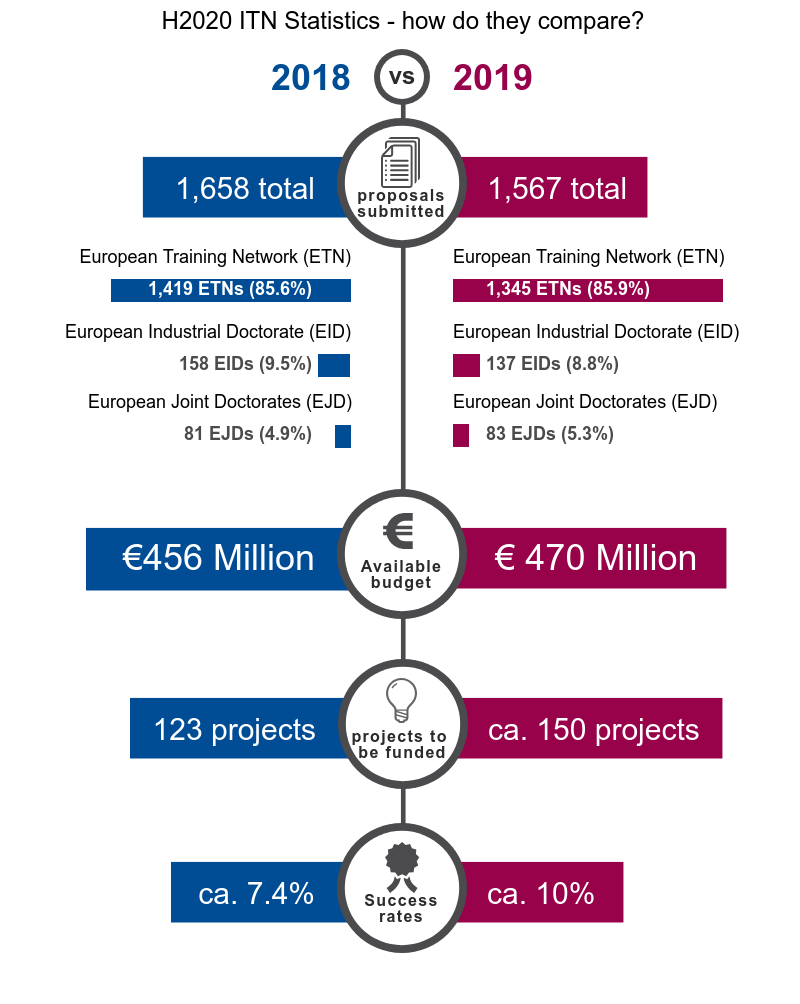Decreases and bugs – Early ITN 2019 submission statistics
19th January 2019 at 1:29 pm
Last year we already observed an unexpected yet slight decrease in ITN submissions. While we were speculating whether this was just an exception or the starting point for a trend to come we now have confirmation: ITN submissions have, for the first time since the inception of the programme, decreased for two successive years. It appears that peak ITN was reached in 2017. Currently, we can only speculate as to what the reasons might be for researchers losing interest in ITNs.
The closing of the submission window last week (15th January 2019) should be a time of relief for many coordinators and partners. Sleepless nights and weekend meetings would have been the norm for countless researchers and proposal writers during the final weeks before the deadline. While the worry of whether the project will receive funding or not might set in soon, the first days after hitting submit for the final time should be a celebration of what has been achieved. This year, the celebrations were replaced by a sense of dread as a server-side bug within the EU web portal led to errors in the Part A of the proposal document, the so-called SEP file, made available for download within 72 hours after the submission deadline.
Fewer proposals + higher budget = increased success rate?
Interest in all three types of ITNs has decreased equally. There were a total of 91 fewer proposals submitted, however, the distribution across ETN, EID and EJD remains comparable to last years’ statistics. To visually compare this and last years’ submission statistics we’ve created an infographic displaying the most relevant and currently available facts:

As can be seen in the infographic, the budget has not decreased but has, as in recent years, been increased. Could the higher budget lead to a higher success rate? Potentially yes, but after what we observed last year nobody knows until the number of funded projects is released. The cost per project depends on the planned number of early stage researchers and can thus lead to variation in the overall budget requested.
The reason for the decreasing submissions will only become apparent once the more detailed statistics are published. Possible explanations could be researchers losing interest in ITNs due to the low success rates or a Brexit-effect following the developments in the UK, leading to fewer available British partners.
Don’t panic! Bugs in part A
After reading the submitted Part A of proposals we helped prepare, many faces turned red in anger. In places, the budget was incorrect or missing and other parts appeared to be out of date, despite multiple pairs of eyes having looked at the documents. For two days the confusion lasted, until the EC finally sent an email to all coordinators and partners explaining the situation. Errors lead to the wrong print preview being made available for download. However, the latest Part A has not disappeared and will be used for the evaluation. The correct Part A should be made available to download shortly (though we have not received an exact timeframe).
Evaluation results by June
The evaluation results will be communicated within 5 months after the submission deadline, i.e. at the latest on the 14th June 2019. However, it may well be that the project coordinators and partners will be informed a few weeks earlier, namely in late May (just like last year). As in recent years, we will be following up the evaluation results with a more in-depth article analysing the results.
Your ITN proposal and accelopment
What started out back in 2008 during the 7th Framework Programme with the Initial Training Networks HEALING, SYSWIND, REFINE and TRAIN-ASAP as well as the NeoGel European Industrial Doctorates (EID) programme, has become a long history of supporting training networks since. Our success has not halted with the transition to Horizon 2020, in which we successfully support the Horizon 2020 European Training Networks (ETNs): ClickGene, EXCILIGHT, PEARRL, Train2Target, EuroNeurotrophin, ImmerSAFE and LightDyNAmics. Three more ITNs have just started or are just about to start: NanoCarb (ETN, 01.10.18 – 30.09.2022), STACCATO (EID, 01.01.2019 – 31.12.2022) and MUSIQ (ETN, 01.04.2019 – 31.03.2023). Our first role typically is to support the proposal writing and to execute the grant preparations with the EC. Then, during the project implementation, we work as a Partner Organisation assisting in project management tasks, coordinating the dissemination activities and/or contributing to the training activities with Transferable Skills Workshops. More details are available on our website. Ask for any of our ITN experts Dr Jeanette Müller or Dr Johannes Ripperger.
